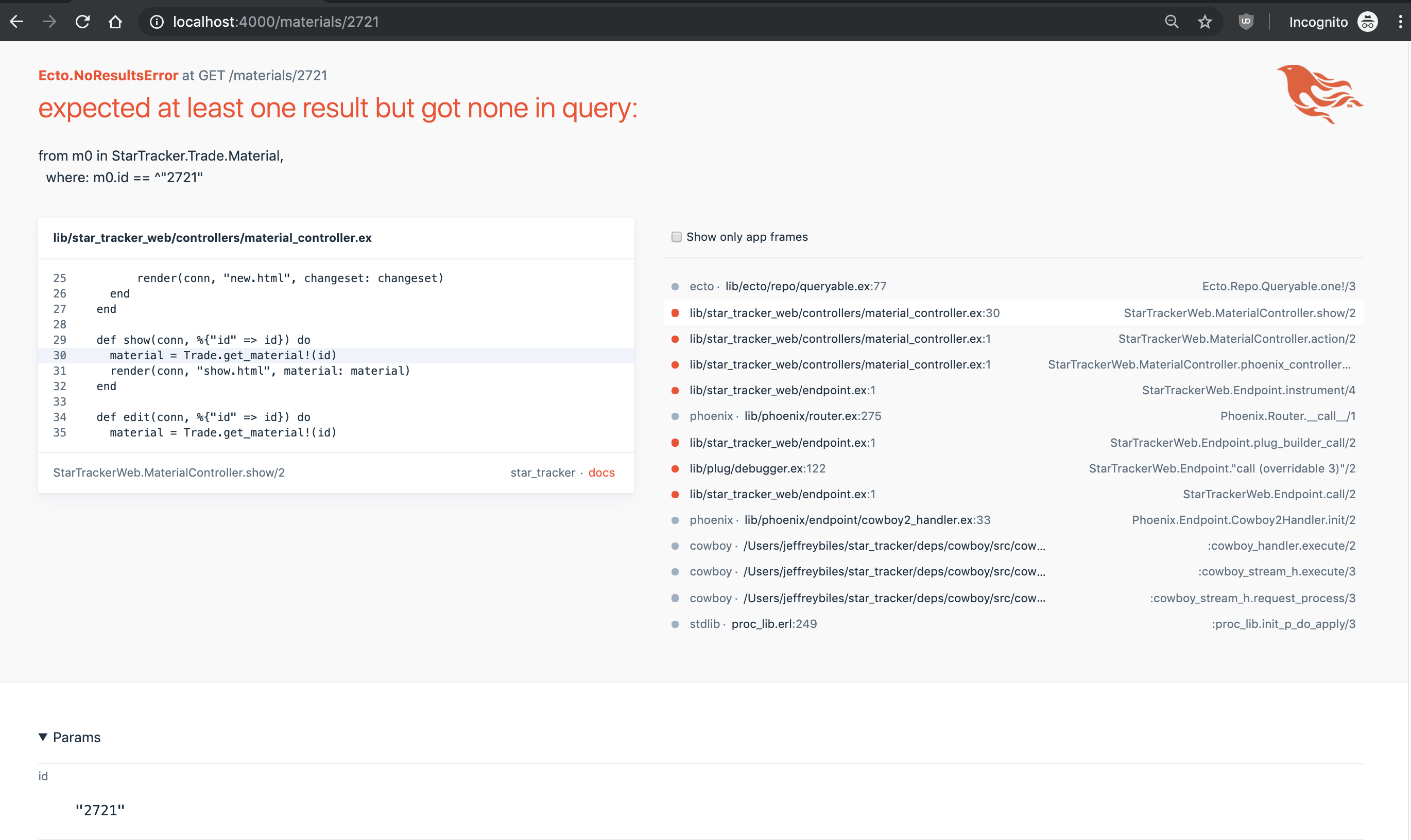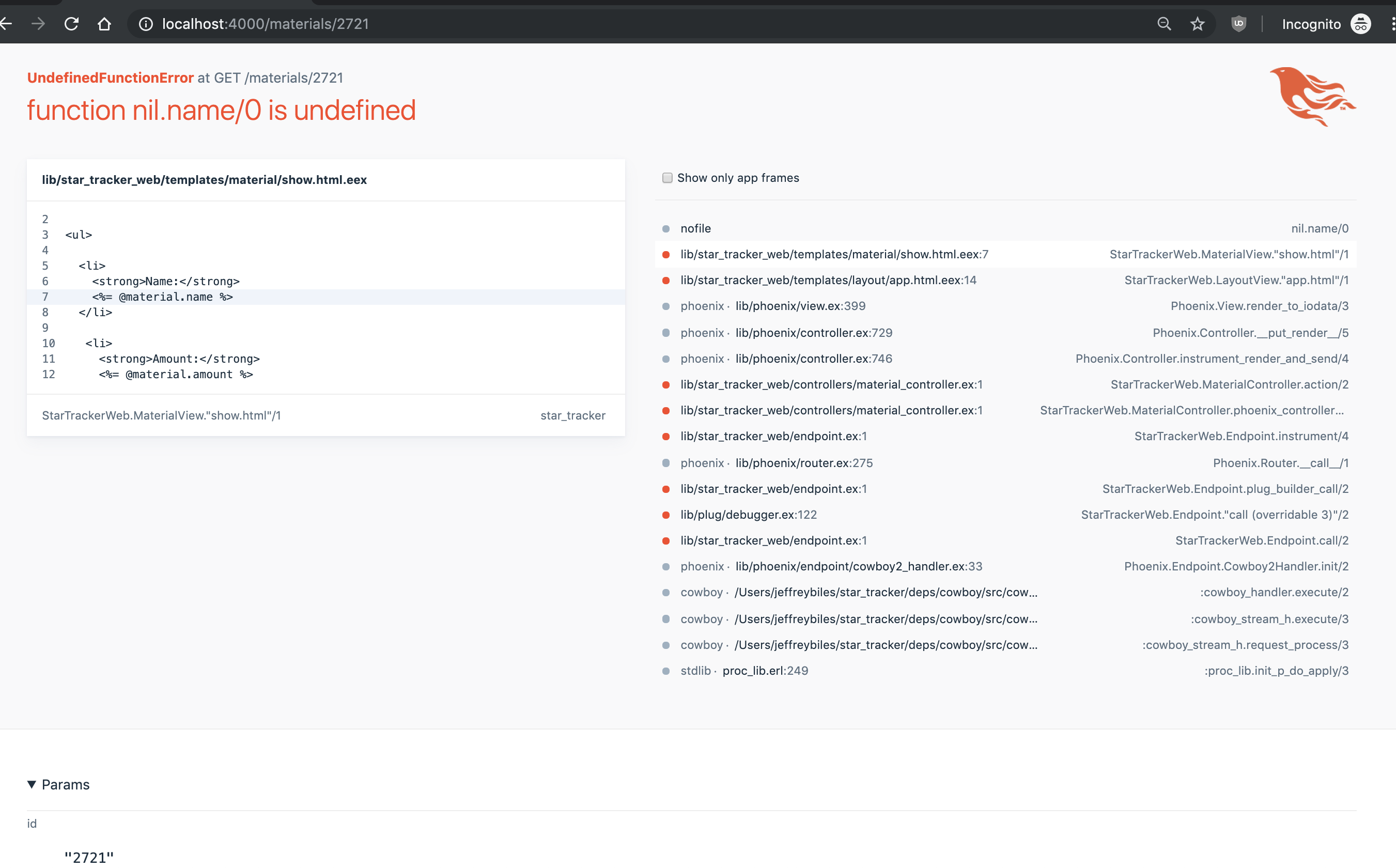Generating a Resource
The Material Show Page
In the last chapter we went over the Materials Index page. We started from how the route matches a URL to a controller, then showed how the controller gets data from the database to the template (via a method on the context), took a detour to explore the Material model, then finally went over the Embedded Elixir template.
This chapter will do the same thing for the Material Show page. It will be shorter because the show page shares many things in common with the index page. However, aside from the review, there are still some interesting new techniques to be learned that we’ll be using throughout our Phoenix app.

The Show Route
We have one line in our web/router.ex file to represent all of the Material-related routes:
resources "/materials", MaterialControllerThis route macro could expand out to seven different routes, including the show route:
get "/materials/:id", MaterialController, :showWe’re matching the URL to the show action on the MaterialController, and giving it one param: :id.
Pattern Matching on Map
The show action is as follows:
def show(conn, %{"id" => id}) do
material = Trade.get_material!(id)
render(conn, "show.html", material: material)
endThe first thing you may notice is how we’ve defined our params argument; instead of simply putting them all in params and pulling them out later, we’re pattern-matching using %{"id" => id}.
There are two aspects to this. One is simply pulling information out of the params Map, and could be replicated with the following code:
def show(conn, params) do
id = params["id"];
material = Trade.get_material!(id)
render(conn, "show.html", material: material)
endThe other aspect to pattern-matching on a Map is that it will refuse to match unless the data is provided as expected. Let’s go back to our LearningElixir module and create a new inspire function:
defmodule LearningElixir do
def my_map do
%{
"name" => "Enterprise",
"type" => "CodeShip",
"mission" => "To explore strange new techniques, to seek out new programming languages and new web frameworks, to code boldly go where no man has gone before"
}
end
def inspire(%{"name" => name, "type" => type, "mission" => mission}) do
"These are the voyages of the #{type} #{name}. Its five-year mission: #{mission}"
end
endThen we can run the following in the command line:
iex()> LearningElixir.my_map |> LearningElixir.inspire
"These are the voyages of the CodeShip Enterprise. Its five-year mission: To explore strange new techniques, to seek out new programming languages and new web frameworks, to code boldly go where no man has gone before"It automatically mapped the values in my_map to the arguments in inspire. But what happens if we feed it a map that doesn’t have all the required key-value pairs?
iex() %{"name" => "Jim", "type" => "CodeShip"} |> LearningElixir.inspire
** (FunctionClauseError) no function clause matching in LearningElixir.inspire/1
The following arguments were given to LearningElixir.inspire/1:
# 1
%{"name" => "Jim", "type" => "CodeShip"}
iex:10: LearningElixir.inspire/1Pattern-matching on the keys protects the function from running unless the map that’s been given to it has all the required information. This can catch a large class of possible errors, and prevents you from having to do null checks on those keys (like you would have to do in Ruby or Javascript).
The problem here: Jim has no mission. Hard to inspire people without a mission!
The careful observer will note that we used Strings to match instead of atoms. If you try to match a URL parameter with atoms, it will give the “no function clause matching” error.
Repo.get! and exclamation point functions
Back to our show action:
def show(conn, %{"id" => id}) do
material = Trade.get_material!(id)
render(conn, "show.html", material: material)
endThe next line is about how we get the selected Material. It calls out to the Trade context, so let’s look there to see what it does.
def get_material!(id), do: Repo.get!(Material, id)First, this is a shortcut for short methods. It’s the same as the following:
def get_material!(id) do
Repo.get!(Material, id)
endIf you have a lot of short lines, then the one-line version can be nice. Now back to the database interaction!
Repo.get! takes two required arguments: the record type (Material) and the id of the record we’re trying to get. Remember, id is automatically assigned when we create a record and is unique per type of record, so the two pieces of information we’re giving Repo.get! is always enough information to uniquely identify a record.
If you look at the list of functions on Repo, you may notice something funny… in addition to Repo.get! there’s also a Repo.get function. It has the same name, but without the exclamation point. This is a shorthand adopted from Ruby; an exclamation point tells the user that the function will throw an error if doesn’t work instead of failing silently.
Let’s test this out by putting in an id that we don’t have yet:

What a nice error! It points to the exact line with our failing Trade.get_material! call and gives us the information that we fed into the function. Plenty of information to reconstruct what went wrong.
Now let’s try removing the exclamation point, and see what happens if we feed in a bad ID with Repo.get:

What a terrible error. “function nil.name/0 is undefined”. Because our app is still small, and because I have experience with errors like this, I can infer the problem is that @material is nil, and trace that back to where @material is defined, with Repo.get. But that’s a lot of unnecessary work, and if the app is big or you’re a beginner, then it may be overwhelming. The default — Repo.get! — is much better.
Anyways, back to our controller. Our last line is very familiar: render(conn, "show.html", material: material). It renders the show template and feeds it the material we grabbed.
The Show template
Here’s the show template:
<h1>Show Material</h1>
<ul>
<li>
<strong>Name:</strong>
<%= @material.name %>
</li>
<li>
<strong>Amount:</strong>
<%= @material.amount %>
</li>
</ul>
<span><%= link "Edit", to: Routes.material_path(@conn, :edit, @material) %></span>
<span><%= link "Back", to: Routes.material_path(@conn, :index) %></span>Most of this should be review: the header (h2), the list (ul and li), displaying data (<%= @material.name %>), and creating links (<%= link "Edit", to: Routes.material_path(@conn, :edit, @material) %>).
The only new thing is the <strong> tag, and it’s pretty simple: it bolds the text inside. It is preferred to using the bold (<b>) tag directly because you can always redefine what the <strong> tag means; bolding is only a default.
Conclusion
In addition to reviewing the core Phoenix pattern, we saw two important new techniques- exclamation point functions and pattern matching on Map keys. You’ll see both of these a lot throughout your Phoenix app and grow to appreciate their usefulness.
Exercises
- Add the
idproperty to the top of the list, above the name. - Add the
updatedAtandcreatedAtproperties to the bottom of the list, below the amount. - Make a version of the
inspirefunction that doesn’t require a mission. Not very inspiring, is it? Now make one that requires a mission but doesn’t require a spaceship name or type. Test each of them in the command line, making sure that the version with all three keys is triggered when all three keys are available, but the other two versions are triggered when keys are missing.
These are the results you should get:
iex()> %{"mission" => "Write awesome code"} |> LearningElixir.inspire
"Your mission: Write awesome code"
iex()> %{"name" => "Jeffrey", "type" => "Human"} |> LearningElixir.inspire
"These are the voyages of the Human Jeffrey."
iex()> %{"name" => "Jeffrey", "type" => "Human", "mission" => "Make learning programming more fun and less frustrating"} |> LearningElixir.inspire
"These are the voyages of the Human Jeffrey. Its five-year mission: Make learning programming more fun and less frustrating"Hint: the order that you have the function versions in matters.
Buy the Ebook